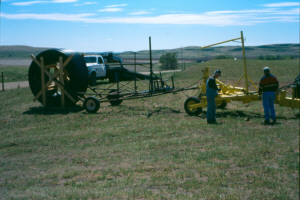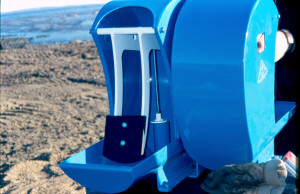|
Watering Systems
Demonstration
Project Summary: The E.C.A.F.A was the first producer group to
develop a project utilizing different livestock watering systems (solar,
windmill, and nose pumps). We wanted to test livestock watering systems in
order to provide clean water to cattle. We also wanted to improve livestock
gains, and keep dugout maintenance costs reduced by not allowing cattle to have
access. These systems worked well during the summer and early fall, but we
quickly found that they required a lot of maintenance during cold weather.
Ranchers are not prepared to take time, each night, in the fall to drain the
lines to keep the pumps from cracking. Therefore, we looked for a watering
system, which would work during the winter. In 1998, we initiated two projects
using a livestock nose pump, which was guaranteed not to freeze. Preliminary
data has shown that these “Idiehl” winter livestock nose pumps do work in late
fall and winter under certain conditions. In 1999, a new prototype, solar panel
and wind generator, winter watering system called the “capsule” was installed.
Preliminary data shows this system needs modifications, but was working
reasonably well. This year we were able to install an A-DC solar system, CAP
Ice King solar system, Dutch Industries Windmill, Frostfree Nosepumps and we
put in an underground waterline using a pipeline plow provided by John
Gattey. A new portable watering system
“Trio Grand Trough” was also included in the project.
Objectives:
·
To provide
livestock with a year-round water supply that is not only economical, but has
less contamination from silt and livestock wastes.
·
To allow the
producer to improve livestock water quality and conserve the sustainability of
existing water sources.
·
To demonstrate
water conservation alternatives to livestock producers who wish to water their
cattle all year long. Both water quantity and quality will be considered.
·
To promote the
use of renewable energy sources in winter livestock watering systems.
·
To explore the
costs of establishing a reliable winter livestock watering system.
Co-operators: Kevin
Manning
Russel Froland
Rick Hope
Dean Holte
Bryon Mailer
Frank
Manning
John Gattey
Legal Land Location:
SE-1-41-9-W4 Kevin Manning
(winter system)
S
W-33-38-6-W4 Russel Froland (summer system)
SW-30-38-7-W4 Rick Hope (winter system)
NE-24-40-8-W4 Dean Holte
(winter system)
NE-17-39-4W4 Frank Manning (winter
system)
SW-4-39-5W4 Bryon Mailer (summer system)
19-36-5W4 John Gattey (summer system)
Background/ Project
Description: In 1998, two “Idiehl”
winter livestock nose pumps were purchased and installed at two different
locations. Each site had a large culvert installed vertically to a depth of
10-12 feet. To feed the culvert a 2-inch suction hose was trenched from the
dugout to the bottom of the culvert. Trench and culvert were back-filled with
gravel, and the livestock nose pump was placed on a lid over the culvert. One
co-operator (Pat McKinnon) also installed a number of summer livestock nose
pumps (Aquamat and Lister) near the winter livestock nose pump. In 2001, a
proto type solar panel and wind generator winter watering system was installed
at Kevin Manning’s. 2002 brought us a few new systems to install; these systems
include the A-DC Solar system, Ice King from CAP Solar, Frostfree Nosepump,
Dutch Industries Windmill, Trio Grand portable watering system, and the water
pipeline distribution system that was installed at Russel Froland’s.
Observations:
Kevin Manning’s System: CAP solar “Capsule” water system
Due to the dry weather over the past two years Kevin was
not able to use this watering system. The water level in the dugout that feeds
the water system has dropped quite low. We hope to be able to monitor this
system again in the following years.
Russel Froland’s System: Water pipeline system

In 2002, a waterline was plowed in at Russel Froland’s
west of Provost on Highway 600. The pipeline was plowed in by John Gattey with
his pipeline plow equipment. This pipeline runs along the fence line of Russel’s
land and was plowed in at 2 feet deep. The waterline runs ¾ of a mile to a tire
water trough that Russel had installed.
A jet pump was used to push the water through the line. Russel did
however have to purchase another pump to move the water. It is recommended that
this waterline should be drained in the fall by using a foam pig and having a
compressor truck blow the line. As well in the spring the foam pig should be
used to push the air out of the line before putting water in the line.
Rick Hope’s System: CAP Solar “Ice King” water system
This system is working reasonably well. There are a few problems we have to work
through with this system.
Dean Holte’s System: A-DC Solar water system

This system is working extremely well.
Frank Manning System: Frostfree
Nosepumps

Two livestock nose pumps were installed. Frank’s cows have gotten accustomed to the
new system and it seems to be working very well to date.
Bryon Mailer’s System: Dutch
Industries Windmill

Bryon has had problems with sand filtering into the
pump. In the spring he is hoping to do a
major pumping program on the system and see if he can get rid of the sand
problem.
John Gattey’s System: Trio Grand
Portable watering system
This system has performed well over the summer time. No problems have been noted to date.
Future Plans: We will continue to monitor the watering systems
that have been installed and we will be looking at trying any new systems that
may come on the market in the near future.
Back to top
|